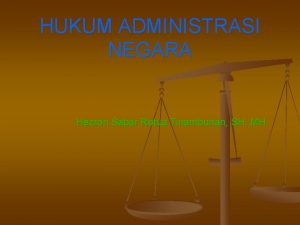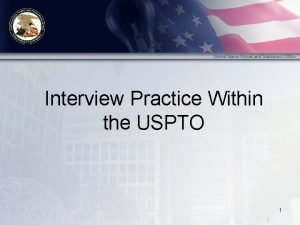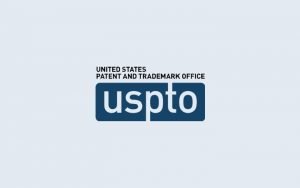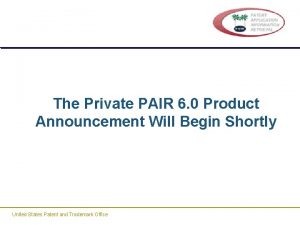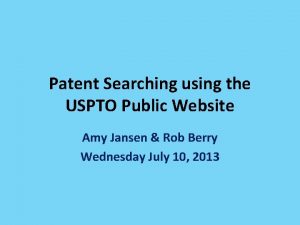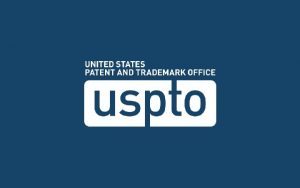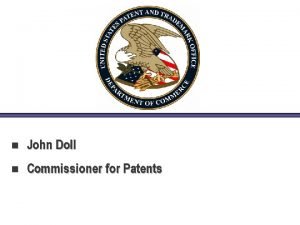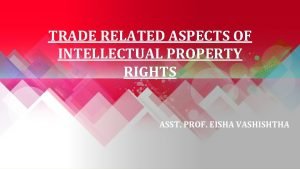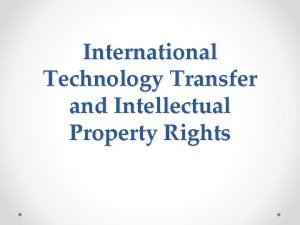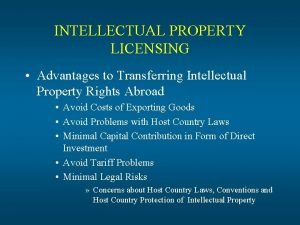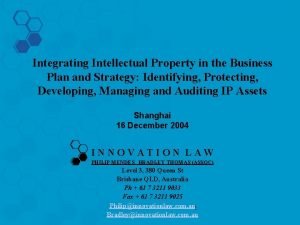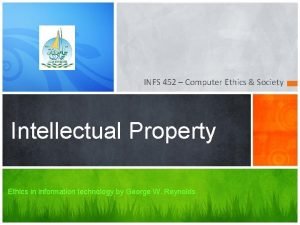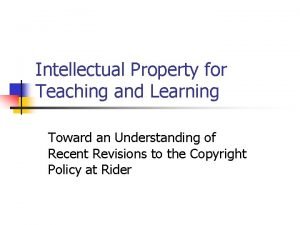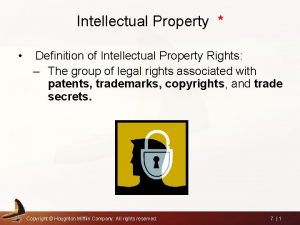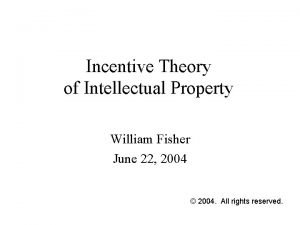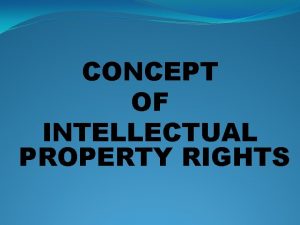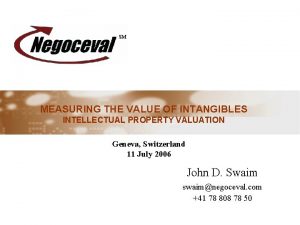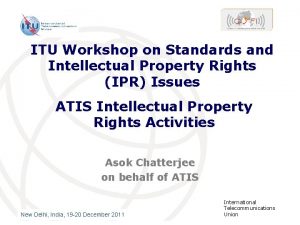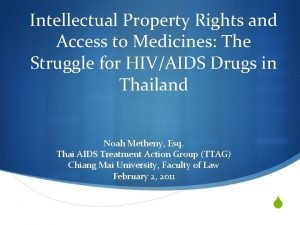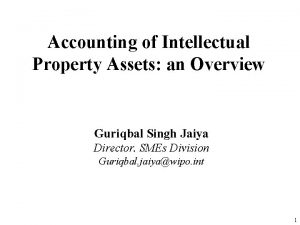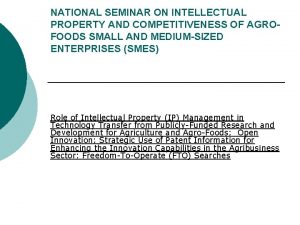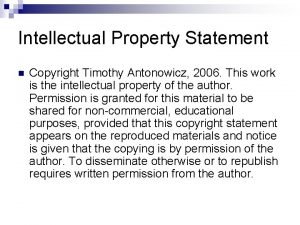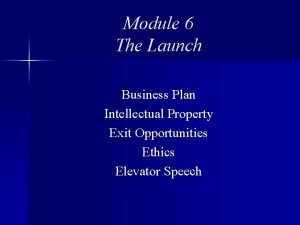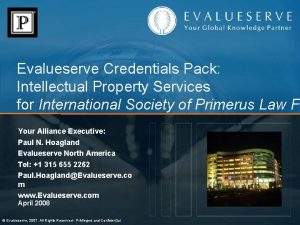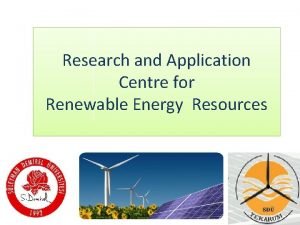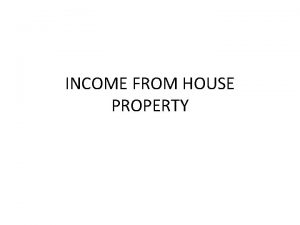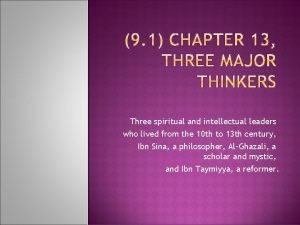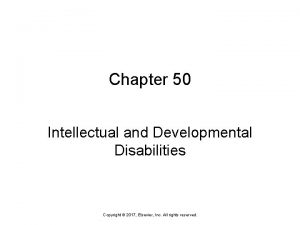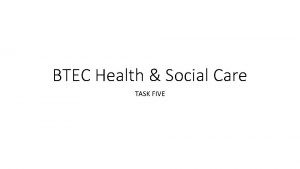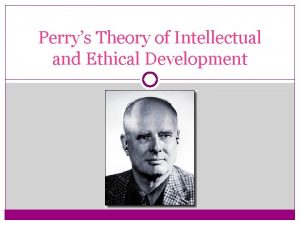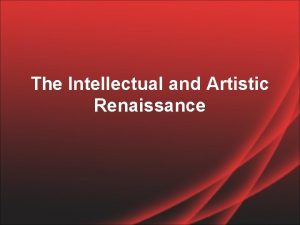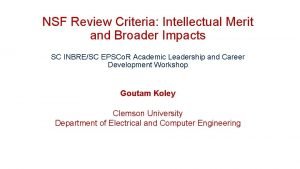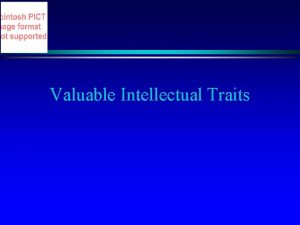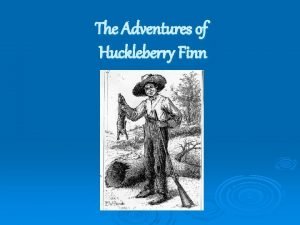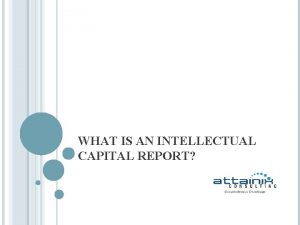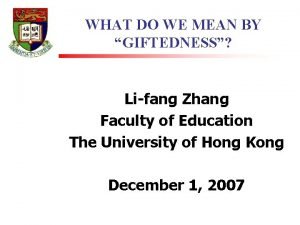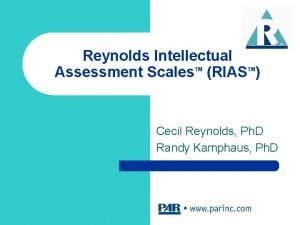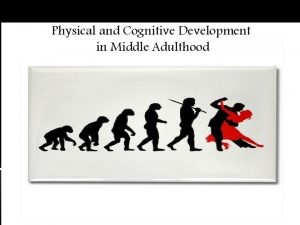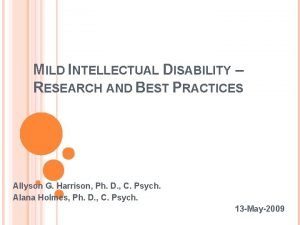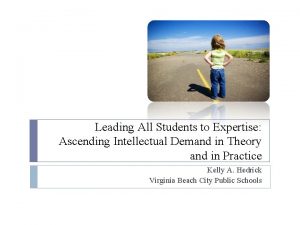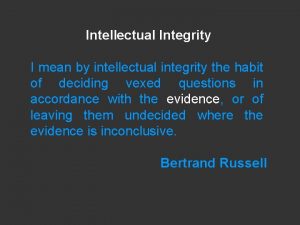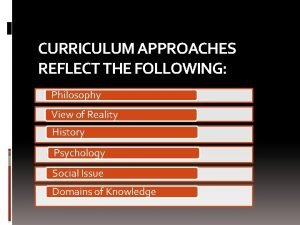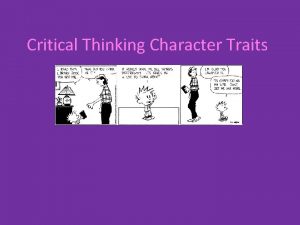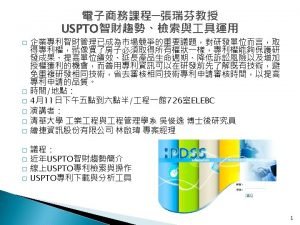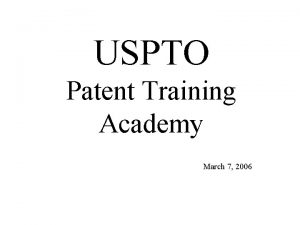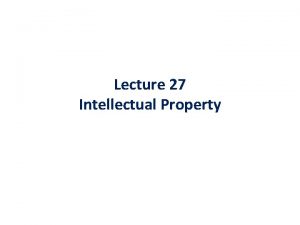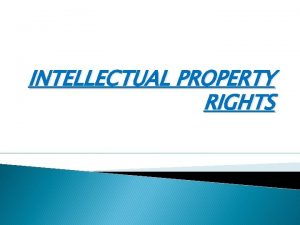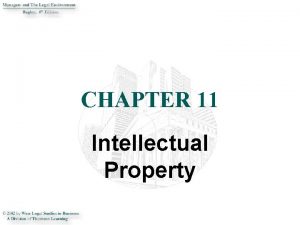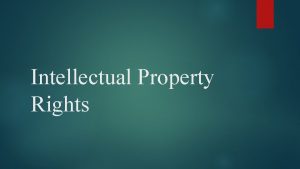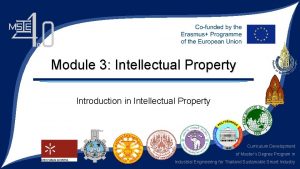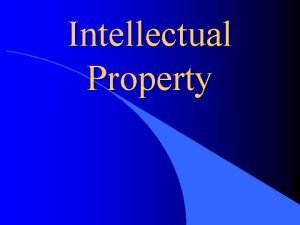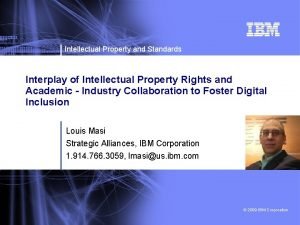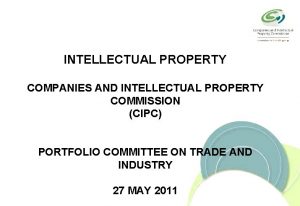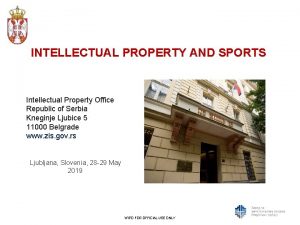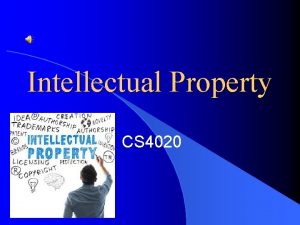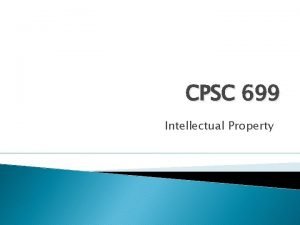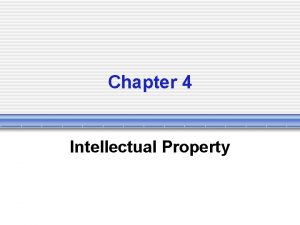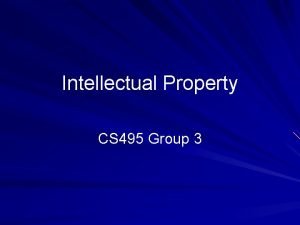Introduction to Intellectual Property and USPTO Resources Hezron





























































- Slides: 61


Introduction to Intellectual Property and USPTO Resources Hezron Williams Supervisory Patent Examiner (SPE) Texas Regional Office Hezron. Williams@uspto. gov (469) 295 -9000

The USPTO in FY 16

USPTO Offices


Intellectual Property

What is Intellectual Property (IP)? 1. 2. 3. 4. Patents Trademarks Copyrights Trade Secrets

Overview of Intellectual Property What’s Protected? Examples Protection Lasts for: Utility Patent Inventions i. Pod, chemical fertilizer, process of manipulating genetic traits in mice 20 years from the date of filing regular patent application Design Patent Ornamental (non functional) designs Unique shape of electric guitar, design for a lamp 14 years Copyright Books, photos, music, fine art, graphic images, videos, films, architecture, computer programs Michael Jackson’s Thriller (music, artwork and video), Windows operating system The life of the author plus 70 years (or for some works, 95 years from first publication) Trade Secret Formulas, methods, devices or compilations of information which is confidential and gives a business an advantage Coca Cola formula, survey methods used by a pollster, new invention for which patent application has not been filed As long as infor mation remains confidential and functions as a trade secret Trademark Words, symbols, logos, designs, or slogans that identify and distinguish products or services Coca Cola name and distinctive logo, Pillsbury doughboy character As long as business continuously uses trademark in connection with goods or services

Trademarks

What is a Trademark? A trademark is a word, phrase, symbol or design, or a combination of words, phrases, symbols or designs, that identifies and distinguishes the source of the goods of one party from those of others. A service mark is the same as a trademark, except that it identifies and distinguishes the source of a service rather than a product. 10

EXAMPLES OF TRADEMARKS ü Trademarks can be WORDS ü Trademarks can be DESIGNS STARBUCKS NIKE TARGET 11

EXAMPLES OF TRADEMARKS Trademarks can also be: ü SMELLS ü COLORS ü SOUNDS ü SHAPES ü PACKAGING 12

First Trademarks (U. S. ) Trademark #1: Oct. 25, 1870 The first U. S. registration was granted in 1870 for an eagle logo used for paints by Averill Chemical Paint Co. , no longer in use. Oldest Trademark still in use: The oldest U. S. registered trademark still in use is trademark reg. no 11210, a depiction of the Biblical figure Samson wrestling a lion, registered in the United States on May 27, 1884 by the J. P. Tolman Company.

Copyrights

What is Copyright? Copyright is a legal protection for the authors of “original works of authorship, ” including literary, dramatic, musical, artistic, and certain other intellectual works.

Things Protected by Copyrights

Things Protected by Copyright Logos Product design and packaging Advertising and promotional materials Instruction manuals Educational materials Software Source Code Website Content

Trade Secrets

What is a Trade Secret? Trade secrets consist of information and can include a formula, pattern, compilation, program, device, method, technique or process. To meet the most common definition of a trade secret, it must be used in business, and give an opportunity to obtain an economic advantage over competitors who do not know or use it. 19

Patents vs Trade Secrets Patents and Trade Secrets are really different sides of the same coin. • • Utility Patents last 20 years from the time of earliest U. S. benefit date claimed. You get exclusive rights for that time. You must disclose how to make and use your invention within your application. There maybe legal remedies should someone make, use or sell your invention without your permission. Someone can still try and improve upon what you have done and get a patent on that improvement. • • Trade Secrets last as long as it remains a secret. You must take reasonable steps to keep your trade secret secure. There maybe legal remedies should someone steal your trade secret. Someone can still try to reverse engineer what you have done.

Examples of Trade Secrets

Patents

What Is A Patent? • The grant of a property right to an inventor (USPTO) ü The right to exclude others from: ü Making, ü Using, ü Offering for sale, or ü Selling or Importing the invention in the United States ✘What is granted is NOT the right to make, use, offer for sale, sell or import, but ü The right to exclude others from making, using, offering for sale, selling or importing the invention.

3 TYPES OF PATENTS Utility patents • Protects how an invention works, functions or is made for 20 years from filing date ü ü Process Machine Article of Manufacture Composition of Matter Design patents • Protects the way a product or article looks, the ornamental expression for 15 years from the date of grant Plant patents • Protects newly invented strains of asexually reproducing flowering plants, fruit trees, and other hybrid plants for 20 years from filing date

Provisional vs. Non-provisional • • Provisional Non-provisional Not examined or published One-year time limit Only for utility patents A low-cost way to establish an early effective filing date (priority date) in a nonprovisional patent application with few formalities • Examined • Published 18 months from earliest filing date (unless a request for a non-publication at filing) • Can become a patent 25

Thomas Alva Edison Incandescent Lightbulb

Wright Brothers Flying Machine Patent # 821, 393 (1906)

Popsicle Patent One day in 1905, Frank Epperson, an 11 year old, mixed some soda water powder and water and left the mixture on the back porch overnight with the stirring stick still in it. The temperature dropped to a record low that night and the next day Frank had a stick of frozen soda water to show his friends at school. Later he began a business producing "Epsicles" in seven fruit flavors. The brand name "Epsicles" was later changed to Popsicle® brand.

Fire-Escape

Design Patents: Video Game System

Design Patent D 82, 802 W. E. Disney Toy or similar article

First Patents (U. S. ) Patent X 1: Potash by Samuel Hopkins Examined by Thomas Jefferson July 31, 1790 Patent 1: Traction Wheel (Train Wheel) by John Ruggles July 13, 1836

Patent Application Examination

Patent Examination: The Examiner Appeal Application is filed by Inventor or Assignee USPTO Pre-Exam Amendment and/or argument EXAMINER APPLICANT Rejection and/or objection Notice of Allowance USPTO Grants Patent Abandonment

The Examination Patent Examiner reviews contents of the application for compliance with all U. S. patent legal requirements. “An applicant is entitled to a patent unless…” * The requirements of U. S. patent law are not met. *(35 USC § 102) The burden is on the examiner to show if a patent is not warranted.

What Does a Patent Examiner Do? • Reads and understands the invention set forth in the specification • Determines whether the application is adequate to define the metes and bounds of the claimed invention • Determines the scope of the claims • Searches existing technology for claimed invention • Determines patentability of the claimed invention 36

Can you find the IP in a mobile phone? Trademarks: • Made by "Nokia" • Product "N 95" • Software "Symbian", "Java" Patents: • Data processing methods • Semiconductor circuits • Chemical compounds • Battery/Power Control • Antenna • Optics Copyrights: • Software code • Instruction manual • Ringtone Trade secrets: • ? ? ? Designs (some of them registered): • Form of overall phone • Arrangement of buttons in oval shape • Three dimensional wave form of buttons • Sliding screen © Nokia

Services & Resources at the USPTO

IP Awareness Assessment Tool http: //www. uspto. gov/inventors/assessment

The Patent Pro Bono Program • Assists financially under-resourced independent inventors and small businesses in filing for a patent or responding to Office actions. – – – • Inventors/Applicants – – • Opportunity for patent practitioners to volunteer in their field of expertise. 20 regional programs cover the nation and match inventors with volunteer patent attorneys. Join over 700 attorneys who are willing to volunteer! Have income of 300% below federal poverty guidelines ~ $35, 640 for a household of 1 Pay USPTO filing fees and costs. Demonstrate knowledge of the patent system. • Take training course at http: //www. uspto. gov/video/cbt/certpck/index. htm. Have application prescreened to ensure that there is more than an idea. For more information: – – – Visit www. uspto. gov/probonopatents, Email probono@uspto. gov, or Call John Kirkpatrick, Patent Pro Bono Coordinator, at (571) 270 -3343.

Coverage of Patent Pro Bono Program August 2016

Law School Clinics The USPTO’s Law School Clinic Certification program allows law students enrolled in a participating law school's clinic program to practice Intellectual Property Law before the USPTO under the strict guidance of a Law School Faculty Clinic Supervisor. Students gain experience drafting and filing either patent applications or trademark applications for clients of the law school clinic. Further, as they are authorized to practice before the USPTO, they gain experience answering Office Actions and communicating with either patent examiners or trademark examining attorneys for the applications they have filed.

Law School Clinics South Texas School Southern Methodist University Dedman of Law School of Law patent@stcl. edu trademark@stcl. edu Patent: TX & Louisiana only Trademark: All U. S. Texas A&M Law School patents@law. tamu. edu patentclinic@smu. edu trademarks@law. tamu. edu trademarkclinic@smu. edu Dallas-Ft. Worth and N. TX on All U. S. limited basis

Pro Bono Program vs. Law School Clinics • Some pro bono law school clinics utilize law students in various ways. This is specific to each regional program. • A pro bono program’s affiliation with a particular law school does not mean that the school participates in the USPTO Law School Clinic Program.

Patent and Trademark Resource Centers (PTRCs)

Assistance Centers • Inventor Assistance Center – Hours: M-F, 8: 30 AM-8: 00 PM (ET), except federal holidays – 1 -800 -PTO-9199 (1 -800 -786 -9199) • Trademark Assistance Center – Hours: M-F, 8: 30 AM-8: 00 PM (ET), except federal holidays – 1 -800 -786 -9199 – Trademark. Asssistance. Center@uspto. gov

• “This program brings a voice to the inventor that he normally would not have. . . THANK-YOU!!!!!!!” • Process designed for issues that arise during patent application prosecution; used to get an application “back on track” Use on-line ombudsman form at http: //www. uspto. gov/patents/ombudsman. jsp •

Micro Entity Status • 75% off most patent fees • Low cost submission to establish filing date – Provisional Application Filing Fees • $130 small entity • $65 micro entity • Micro entity certifies that he/she: – Qualifies as a small entity (less than 500 employees); – Has not been named as an inventor on more than 4 previously filed patent applications; – Did not, in calendar year preceding the calendar year in which the applicable fee is paid, have a gross income exceeding 3 times median household income; and – Has not assigned, granted, or conveyed (and is not under obligation to do so) a license or other ownership interest in the application concerned to an entity that, in calendar year preceding the calendar year in which applicable fee is paid, had a gross income exceeding 3 times the median household income.

Need Patent Protection Fast? Need to FAST track your patent? Use Track One! Move your ideas quickly with USPTO's Track One http: //www. uspto. gov/patent/initiatives/usptos-prioritized-patentexamination-program 49

Patent Application Initiatives: During Examination and After close of Prosecution • Post-Prosecution Pilot Program • http: //www. uspto. gov/patent/initiatives/post-prosecution-pilot • National Cancer Moonshot • http: //www. uspto. gov/about-us/national-cancer-moonshot • Quick Path Information Disclosure Statement (QPIDS) • http: //www. uspto. gov/patent/initiatives/quick-path-informationdisclosure-statement-qpids • Interview Practice • http: //www. uspto. gov/patent/laws-and-regulations/interview-practice

AIR Form AIR form allows Applicants to schedule an interview with an Examiner for their pending patent application

Patent Examiner Training Ways Stakeholders Can Help! Patent Examiner Technical Training Program (PETTP): – Share your expertise with Patent Examiners • Lecture on state of the art, emerging trends & new developments in focused technology areas – Satellite offices will support guest lecturers Site Experience Education (SEE) Program: – Patent Examiners visiting with industries – Gain first-hand experience and SEE how technology operates in the field 52

Additional Resources at the USPTO

Inventors Resources Online http: //www. uspto. gov/learning-and-resources/inventors-entrepreneurs-resources 54

Resources at uspto. gov • Patent Process Overview – http: //www. uspto. gov/patents-getting-started/patentbasics/types-patent-applications/utility-patent/processobtaining • EFS-Web “Getting Started - New Users” page – http: //www. uspto. gov/patents-application-process/applying -online/getting-started-new-users • Basic Patent Training for Independent Inventors and Small Businesses – http: //www. uspto. gov/video/cbt/basicpatenttraining/index. htm • ip. Awareness. Assessment – https: //ipassessment. uspto. gov/index. html 55

Resources at uspto. gov • USPTO Fee Schedule – http: //www. uspto. gov/learning-and-resources/fees-andpayment/uspto-fee-schedule • USPTO Forms – http: //www. uspto. gov/patents-forms • Searchable MPEP – http: //mpep. uspto. gov/RDMS/detail/manual/MPEP/curren t/d 0 e 18. xml • Public PAIR – http: //portal. uspto. gov/pair/Public. Pair • Patent Pro Bono Program – http: //www. uspto. gov/patents-getting-started/using-legal -services/pro-bono/patent-pro-bono-program 56

Resources at uspto. gov • Patent Ombudsman – http: //www. uspto. gov/patents/ombudsman. jsp • Law School Clinics – http: //www. uspto. gov/learning-and-resources/ippolicy/public-information-about-practitioners/law-schoolclinic-1 • Law School Clinic FAQs – http: //www. uspto. gov/learning-and-resources/ippolicy/public-information-about-practitioners/law-schoolfaqs • Participating Law Schools in the Texas Region: – SMU Dedman School of Law – South Texas College of Law – Texas A&M University School of Law 57

Resources at uspto. gov • Sample amendment/response to Office action – http: //www. uspto. gov/sites/default/files/we b/offices/pac/dapp/opla/preognotice/forma trevamdtprac. pdf. • Sample 37 CFR 1. 4 signatures – http: //www. uspto. gov/web/offices/pac/dap p/opla/preognotice/sigexamples_alt_text. pd f • Amendment practice – see 37 CFR 1. 121 58

Other Contacts • Pro Se Assistance Program – T: 866 -767 -3848 | E: Independent. Inventor@uspto. gov – http: //www. uspto. gov/patents-getting-started/usinglegal-services/pro-se-assistance-program • Office of Petitions – T: 571 -272 -3282 – http: //www. uspto. gov/patents-applicationprocess/petitions • Application Assistance Unit (AAU) – T: 571 -272 -4000 or 888 -786 -0101 – http: //www. uspto. gov/learning-and-resources/supportcenters/application-assistance-unit-aau 59

Thank You! Taylor Elfervig USPTO – Texas Regional Office Texas. Regional. Office@USPTO. GOV

 Hezron sabar rotua
Hezron sabar rotua Interview request uspto
Interview request uspto Uspto
Uspto Private pair uspto
Private pair uspto Different types of patents
Different types of patents Uspto
Uspto John doll uspto
John doll uspto Trade related aspects of intellectual property rights
Trade related aspects of intellectual property rights Intellectual property rights in professional practices
Intellectual property rights in professional practices Importance of intellectual property
Importance of intellectual property Intellectual property management definition
Intellectual property management definition Licensing advantages
Licensing advantages Intellectual property business plan
Intellectual property business plan Intellectual property in computer ethics
Intellectual property in computer ethics Right to intellectual property of teachers
Right to intellectual property of teachers Intellectual property law definition
Intellectual property law definition Theories of intellectual property william fisher
Theories of intellectual property william fisher Concept of intellectual property
Concept of intellectual property Valuation of ip
Valuation of ip Intellectual property rights
Intellectual property rights Intellectual property rights
Intellectual property rights Characteristics of intellectual property
Characteristics of intellectual property Discuss intellectual property frankly
Discuss intellectual property frankly Gaap accounting for intellectual property
Gaap accounting for intellectual property Intellectual property
Intellectual property Intellectual property statement
Intellectual property statement Intellectual property business plan example
Intellectual property business plan example Evalueserve patent search
Evalueserve patent search Discuss intellectual property frankly
Discuss intellectual property frankly At&t ecommerce
At&t ecommerce The transformation process
The transformation process Fixed and variable resources
Fixed and variable resources Sapratibandha daya and apratibandha daya
Sapratibandha daya and apratibandha daya Chemical properties of citric acid
Chemical properties of citric acid Renewable resources vs nonrenewable resources
Renewable resources vs nonrenewable resources Commutative property vs associative property
Commutative property vs associative property Human resources introduction
Human resources introduction Introduction about energy resources
Introduction about energy resources Income from house property introduction
Income from house property introduction Introduction to property valuation
Introduction to property valuation The intellectual and spiritual leaders.
The intellectual and spiritual leaders. Chapter 50 intellectual and developmental disabilities
Chapter 50 intellectual and developmental disabilities Health and social care intellectual development
Health and social care intellectual development Dualism multiplicity and relativism
Dualism multiplicity and relativism What was a key intellectual movement of the renaissance
What was a key intellectual movement of the renaissance Nsf broader impacts and intellectual merit
Nsf broader impacts and intellectual merit Which intellectual trait includes conscious understanding
Which intellectual trait includes conscious understanding What is the climax of huckleberry finn
What is the climax of huckleberry finn Intellectual capital examples
Intellectual capital examples Intellectual giftedness
Intellectual giftedness Rias-2 score descriptors
Rias-2 score descriptors Cognitive development for middle adulthood
Cognitive development for middle adulthood Borderline intellectual functioning
Borderline intellectual functioning Ascending levels of intellectual demand
Ascending levels of intellectual demand Late adulthood mental development
Late adulthood mental development Intellectual
Intellectual Meaning of intellectual freedom
Meaning of intellectual freedom Intellectual curiosity definition
Intellectual curiosity definition Physical changes middle adulthood
Physical changes middle adulthood Managerial approach to curriculum
Managerial approach to curriculum Intellectual courage in critical thinking
Intellectual courage in critical thinking Critical thinking traits
Critical thinking traits
